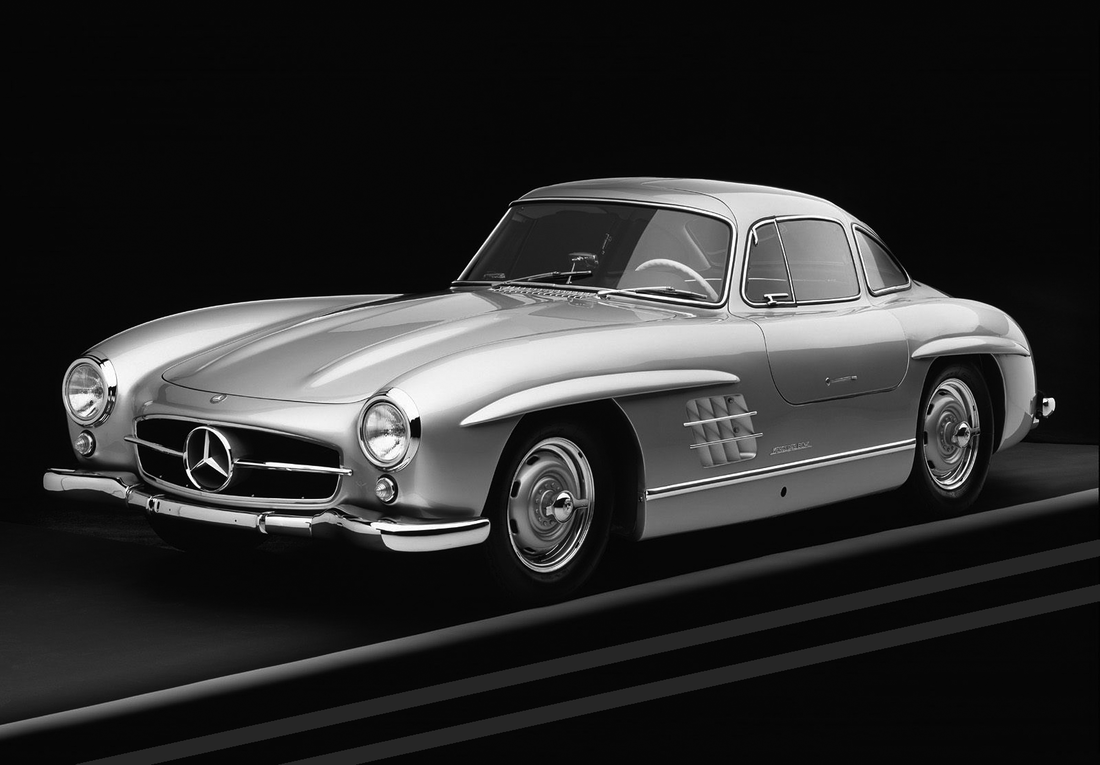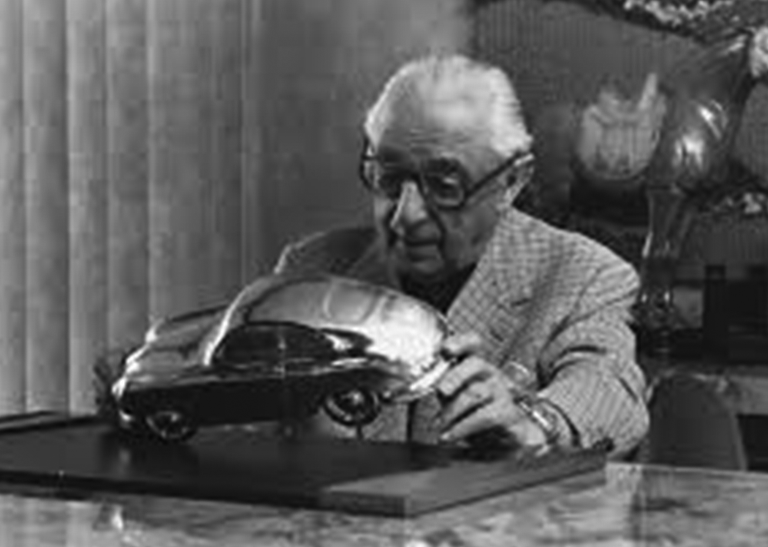Mercedes Benz 300 SL
By Timothy Hogue
Luxury Sports Car
Max Hoffman was responsible for the introduction of many iconic European sports car brands coming to the United States. Thru his dealerships he introduced the American Car Buyer to a whole new breed of sports car sophistication.
Max imported and sold these cars but not only did Max sell these cars, he was considered so important to the industry that he was instrumental in the creation of many popular sports cars, among these was the Mercedes Benz 300 SL.
The Mercedes-Benz 300 SL (chassis code W 198) is a two-seat sports car that was produced by Mercedes-Benz as a gull-winged coupe (1954-1957) and roadster (1957-1963). It was based on the company's 1952 racer, the W194, with mechanical direct fuel-injection which boosted power almost 50% on its standard 3-litre overhead camshaft straight-6 engine. Capable of reaching a top speed of up to 263 km/h (163 mph), it was both a sports car racing champion and the fastest production car of its time.
Max was the Mercedes-Benz's authorized United States importer at the time, who correctly perceived a large American market for such a car. The company introduced the 300 SL in February 1954 at the International Motor Sports Show in New York instead of in Europe in order to get it into U.S. buyers' hands sooner.
SL is the short form for "super-light" in German,Mercedes' first use of the designation, referring to the car's racing-bred light tubular frame construction.
Max imported and sold these cars but not only did Max sell these cars, he was considered so important to the industry that he was instrumental in the creation of many popular sports cars, among these was the Mercedes Benz 300 SL.
The Mercedes-Benz 300 SL (chassis code W 198) is a two-seat sports car that was produced by Mercedes-Benz as a gull-winged coupe (1954-1957) and roadster (1957-1963). It was based on the company's 1952 racer, the W194, with mechanical direct fuel-injection which boosted power almost 50% on its standard 3-litre overhead camshaft straight-6 engine. Capable of reaching a top speed of up to 263 km/h (163 mph), it was both a sports car racing champion and the fastest production car of its time.
Max was the Mercedes-Benz's authorized United States importer at the time, who correctly perceived a large American market for such a car. The company introduced the 300 SL in February 1954 at the International Motor Sports Show in New York instead of in Europe in order to get it into U.S. buyers' hands sooner.
SL is the short form for "super-light" in German,Mercedes' first use of the designation, referring to the car's racing-bred light tubular frame construction.
The 300 SL was created to the specifications that Americans held as an ideal of a European car was at the time.
On the interior, three checkered pattern seats fabrics were available as standard. The combinations of the basic colours were, grey/green, grey/blue and cream/red, however most customers opted for leather upholstery, which became standard on the Roadster. the upward opening gull-wing doors made for an unusually high sill for the buyer to traverse when entering or exiting the vehicle. To help this situation the steering wheel pivoted on its hub a full 90 degrees away from the dashboard. This was a really interesting feature for the sophisticated American car buyer whose car had an authentic European heritage had some really quirky but super cool unique features.These cars stood out!
On the exterior The body consisted mainly of sheet steel, with the bonnet, boot lid, dashboard, sill and door skins made of aluminum. Silver grey was the standard colour; all others were options at an additional expense.
The objective of the overall design was to make the vehicle as streamlined as possible. The exceptional width of the tubular frame along the cockpit allowed the cabin roofline to be inset considerably on both sides, dramatically reducing the frontal area. The frame, however, was also quite high, prohibiting the attachment of normal doors. The only option which had already been used on the W194 race car was to use a door that facilitated the passenger would have to go up and over an exceptionally high and deep sill. These were the aforementioned iconic gull-wing doors. These doors set the tone for the entire uniqueness of the vehicle, allowing it to stand out in a crowd. The gull-wing door has proven to have been an awesome aesthetic choice for Mercedes however in actuality it was really a design necessity.
On the interior, three checkered pattern seats fabrics were available as standard. The combinations of the basic colours were, grey/green, grey/blue and cream/red, however most customers opted for leather upholstery, which became standard on the Roadster. the upward opening gull-wing doors made for an unusually high sill for the buyer to traverse when entering or exiting the vehicle. To help this situation the steering wheel pivoted on its hub a full 90 degrees away from the dashboard. This was a really interesting feature for the sophisticated American car buyer whose car had an authentic European heritage had some really quirky but super cool unique features.These cars stood out!
On the exterior The body consisted mainly of sheet steel, with the bonnet, boot lid, dashboard, sill and door skins made of aluminum. Silver grey was the standard colour; all others were options at an additional expense.
The objective of the overall design was to make the vehicle as streamlined as possible. The exceptional width of the tubular frame along the cockpit allowed the cabin roofline to be inset considerably on both sides, dramatically reducing the frontal area. The frame, however, was also quite high, prohibiting the attachment of normal doors. The only option which had already been used on the W194 race car was to use a door that facilitated the passenger would have to go up and over an exceptionally high and deep sill. These were the aforementioned iconic gull-wing doors. These doors set the tone for the entire uniqueness of the vehicle, allowing it to stand out in a crowd. The gull-wing door has proven to have been an awesome aesthetic choice for Mercedes however in actuality it was really a design necessity.
The engine design was also innovative in that it featured the M186's innovative aluminum head, which had a 30-degree diagonal base that allowed for larger intake and exhaust valves than a standard horizontal joint with the engine block.
To further improve performance, the M198 replaced the W194's triple two-barrel Solex carburetors with a Bosch mechanical direct fuel injection system. Derived from the DB 601 V12 used on the Messerschmitt Bf 109E fighter of World War II, it boosted power almost 25% over the Gran Prix car's, raising output from 175 hp (130 kW; 177 PS) SAE gross to 240 hp (179 kW; 243 PS) SAE gross at 6100 rpm (215 hp (160 kW; 218 PS) DIN at 5800 rpm), over double that of the original Type 300 saloon's 115 hp (86 kW; 117 PS) SAE gross. Compression was set at 8.55:1
To further improve performance, the M198 replaced the W194's triple two-barrel Solex carburetors with a Bosch mechanical direct fuel injection system. Derived from the DB 601 V12 used on the Messerschmitt Bf 109E fighter of World War II, it boosted power almost 25% over the Gran Prix car's, raising output from 175 hp (130 kW; 177 PS) SAE gross to 240 hp (179 kW; 243 PS) SAE gross at 6100 rpm (215 hp (160 kW; 218 PS) DIN at 5800 rpm), over double that of the original Type 300 saloon's 115 hp (86 kW; 117 PS) SAE gross. Compression was set at 8.55:1
The chassis was (similar to contemporary racing cars) a tubular steel frame designed by Mercedes' head engineer Rudolf Uhlenhaut. Rudolf was an Anglo-German engineer and executive for Mercedes-Benz. He had a long association with the Mercedes-Benz racing programme of the 1930s and 1950s, and is best known for his road legal Uhlenhaut Coupé version of the 1955 Mercedes-Benz 300SLR race car. The front wheels are hung on double, unequal length wishbones with coil springs and hydraulic telescopic shock absorbers (also a very modern design) and a torsion bar stabilizer. The Coupe's rear axle was of a two joint design with one joint at each side of the differential at its centre line.
All in all the 300SL was a very modern sports car that infused luxury along with seats of the pants driving fun! This established a clear formula for successful sports -luxury cars which many other have successfully followed. It has always been one of my favorite classic cars and even the spirit of these early cars has been carried into the later iterations of the model.
More than 80% of the 300 SL model’s total production of approximately 1400 units were sold in the US, making it the first Mercedes-Benz widely successful outside its home market and thoroughly validated Hoffman’s assumptions about the American car market. Mercedes-Benz success with the 300 SL changed the company’s image in America from a manufacturer of solid but staid luxury automobiles to one capable of rendering high-performance sports cars.
More than 80% of the 300 SL model’s total production of approximately 1400 units were sold in the US, making it the first Mercedes-Benz widely successful outside its home market and thoroughly validated Hoffman’s assumptions about the American car market. Mercedes-Benz success with the 300 SL changed the company’s image in America from a manufacturer of solid but staid luxury automobiles to one capable of rendering high-performance sports cars.
Max Hoffmans influence in the automobile industry has greatly contributed to the success of many of the most popular, iconic car marques known today and no doubt, the Mercedes Benz 300 SL was clearly among the top of the list of these success stories.
It can be argued that the visionary Max Hoffman, set the stage for the modern luxury sports car.
Hoffman's contributions to both automobile development and sports car racing earned him induction into the Automotive Hall of Fame in 2003
It can be argued that the visionary Max Hoffman, set the stage for the modern luxury sports car.
Hoffman's contributions to both automobile development and sports car racing earned him induction into the Automotive Hall of Fame in 2003
Timothy Hogue,
Founder, MetronGarage-Elevated Garage Journal
Founder, MetronGarage-Elevated Garage Journal







